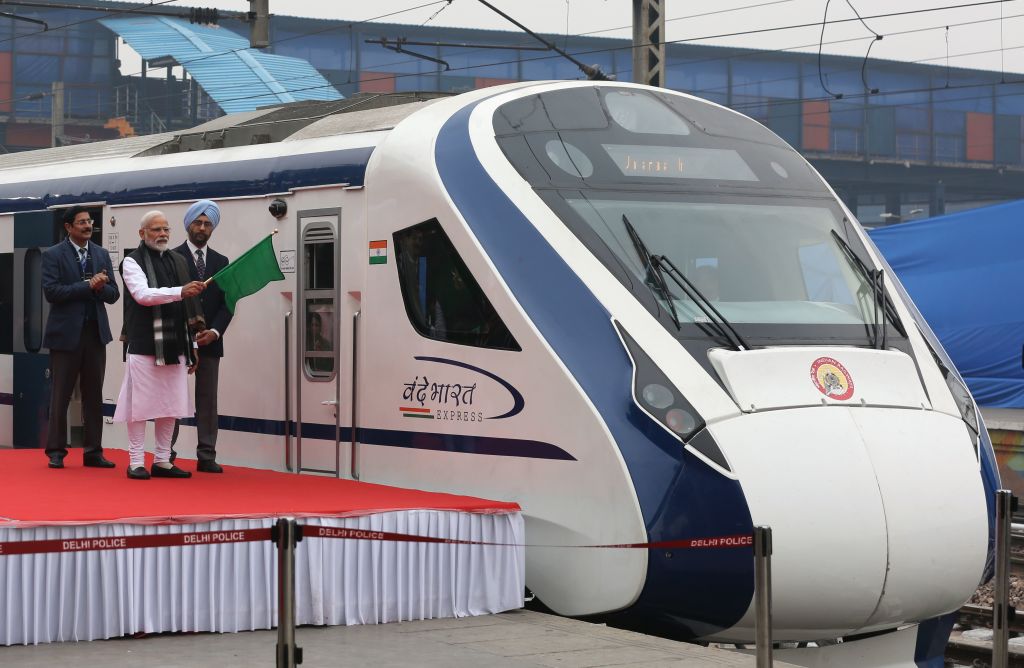- Thursday, April 24, 2025
While it is not the first time that India is seeing launching of trains for political reasons, PM Modi has done it with more purpose and precision.

By: Shubham Ghosh
IT is not new to see Indian prime minister Narendra Modi flagging off the elite Vande Bharat Express trains in different parts of the country. On Tuesday (27), he green-signalled as many as five of the semi-high-speed trains from Bhopal in the central Indian state of Madhya Pradesh, which is ruled by the Bharatiya Janata Party (BJP) and will go to polls later this year.
There has not been a single Vande Bharat Express train that Modi has not flagged off since the first was inaugurated between New Delhi and Varanasi in the northern state of Uttar Pradesh in February 2019, months before the general elections that year.
It is not uncommon to see the prime minister of the country flagging off a new train. But what explains the fact that Modi flags off each Vande Bharat Express train that hits the tracks? The opposition cry that the prime minister is ever thirsty for publicity but is that the only reason why Modi doesn’t leave the job of inaugurating the Vande Bharat trains to even the railway minister Ashwini Vaishnaw?
That Modi attaches immense importance to the Vande Bharat trains is evident from the fact that last December, he virtually flagged off one of them between Kolkata to Jalpaiguri in the eastern state of West Bengal after his mother Heeraben passed away. He only cancelled his travel to Kolkata for inaugurating the train but he did it nevertheless.
There is no doubt that Vande Bharat brings a sense of modernisation in an otherwise sluggish behemoth called Indian Railways. There are not many fast-moving trains that the more-than-a-century old network offers to millions of passengers everyday. It would have been ineffective had Modi wanted to own the few fast ones that already existed before 2014 when he became the prime minister — Rajdhani Express, Shatabdi Express and Duronto Express. So he brought in an entirely new one — Vande Bharat Express — and it became symbolic with the India of his times in many ways.
First of all, Vande Bharat matches Modi’s aspirations. The prime minister has established himself as a leader who has a vision and works fast towards achieving it. His government has even taken up the initiative to introduce bullet trains in India, something which was not imagined much even 15 years ago.
Secondly, Vande Bharat is also about speed. While Indian Railways is not known for its speed and punctuality, Vande Bharat trains have revolutionised train travel in India by reducing time by far. While these trains are still covering short distances — those that can be covered twice in a day — yet launching Vande Bharat Expresses for long distances is only a matter of time. And if they start substantially reducing travel time between far off places in a huge country like India and start giving airways a real competition, the railways, which is often seen as a parameter to gauge a country’s development, will be in for a real change in India.
Train travel in India still holds a special place in the commuter’s heart and Modi is well aware of the fact. Bettering the experience on the tracks by means of speed and modernity certainly gives him a scope to enhance his popularity.
Thirdly, Vande Bharat trains are made in India and that also brings a nationalistic dimension to them and their appeal. By flagging off these trains, Modi tries to establish the fact that they are not just about bettering the travel experience for people but to make them historic. He thus makes every inauguration of the Vande Bharat train a special occasion to drive home the point that it is not just a train but signifies an entire moving nation. The naming (Vande Bharat which means ‘Salute India) is also to be noted as it gives nationalist goosebumps to many.
Finally, there is a political goal. While gifting each state of India a Vande Bharat aims at winning the blessings of the people of that state, be it ruled by the BJP or not, flagging off several Vande Bharat trains in poll-bound states clearly speaks about Modi’s Blitzkrieg strategy to corner the opposition. The BJP lost the southern state of Karnataka last month and with a string of state elections lined up in 2023 before the big general poll of 2024, rail politics is something that Modi chooses to play wisely.
It is not a variety of politics that India is seeing for the first time. Past railway ministers such as LN Mishra, Lalu Prasad, Mamata Banerjee and Nitish Kumar also started different trains in their respective tenures but they did not bring the kind of return they had expected as people viewed them as populist measures.
Modi has tried his best to show that it is not just about populism but a real game-changer in the lives of millions. Services in other trains are still not perfect and a few days ago, the Modi government faced a serious backlash over a three-train accident in the eastern state of Odisha in which almost 300 people were killed.
While it is still early to say that Vande Bharat has changed the railways for the better for ever since a little percentage of India’s railway commuters avail them, but there is no doubt that it has shaken things up.